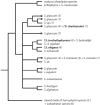Secondary metabolome and its defensive role in the aeolidoidean Phyllodesmium longicirrum, (Gastropoda, Heterobranchia, Nudibranchia)
- PMID: 28405231
- PMCID: PMC5372768
- DOI: 10.3762/bjoc.13.50
Secondary metabolome and its defensive role in the aeolidoidean Phyllodesmium longicirrum, (Gastropoda, Heterobranchia, Nudibranchia)
Abstract
Phyllodesmium longicirrum is the largest aeolidoidean species known to date, and extremely rich in terpenoid chemistry. Herein we report the isolation of a total of 19 secondary metabolites from a single specimen of this species, i.e., steroids 1-4, cembranoid diterpenes 5-13, complex biscembranoids 14 and 15, and the chatancin-type diterpenes 16-19. These compounds resemble those from soft corals of the genus Sarcophyton, of which to date, however, only S. trocheliophorum is described as a food source for P. longicirrum. Fish feeding deterrent activity was determined using the tropical puffer fish Canthigaster solandri, and showed activity for (2S)-isosarcophytoxide (10), cembranoid bisepoxide 12 and 4-oxochatancin (16). Determining the metabolome of P. longicirrum and its bioactivity, makes it evident that this seemingly vulnerable soft bodied animal is well protected from fish by its chemical arsenal.
Keywords: Nudibranchia; Phyllodesmium longicirrum; chemical defense; chemoecology; natural compounds.
Figures












Similar articles
-
Defensive Diterpene from the Aeolidoidean Phyllodesmium longicirrum.J Nat Prod. 2016 Mar 25;79(3):611-5. doi: 10.1021/acs.jnatprod.5b00860. Epub 2015 Dec 9. J Nat Prod. 2016. PMID: 26649919
-
Defense in the aeolidoidean genus Phyllodesmium (Gastropoda).J Chem Ecol. 2014 Sep;40(9):1013-24. doi: 10.1007/s10886-014-0496-z. Epub 2014 Sep 23. J Chem Ecol. 2014. PMID: 25244950
-
Cryptic Species Account for the Seemingly Idiosyncratic Secondary Metabolism of Sarcophyton glaucum Specimens Collected in Palau.J Nat Prod. 2020 Mar 27;83(3):693-705. doi: 10.1021/acs.jnatprod.9b01128. Epub 2020 Jan 23. J Nat Prod. 2020. PMID: 31971803
-
Terpenes from the soft corals of the genus Sarcophyton: chemistry and biological activities.Chem Biodivers. 2013 Dec;10(12):2161-96. doi: 10.1002/cbdv.201200122. Chem Biodivers. 2013. PMID: 24327439 Review.
-
The Soft Coral Sarcophyton trocheliophorum: A Warehouse of Terpenoids with Structural and Pharmacological Diversity.Mar Drugs. 2022 Dec 29;21(1):30. doi: 10.3390/md21010030. Mar Drugs. 2022. PMID: 36662203 Free PMC article. Review.
Cited by
-
Bioactive Compounds from Marine Heterobranchs.Mar Drugs. 2020 Dec 21;18(12):657. doi: 10.3390/md18120657. Mar Drugs. 2020. PMID: 33371188 Free PMC article. Review.
-
A High-Content Screening Assay for the Discovery of Novel Proteasome Inhibitors from Formosan Soft Corals.Mar Drugs. 2018 Oct 21;16(10):395. doi: 10.3390/md16100395. Mar Drugs. 2018. PMID: 30347865 Free PMC article.
-
Looking at the Nudibranch Family Myrrhinidae (Gastropoda, Heterobranchia) from a Mitochondrial '2D Folding Structure' Point of View.Life (Basel). 2021 Jun 18;11(6):583. doi: 10.3390/life11060583. Life (Basel). 2021. PMID: 34207329 Free PMC article.
-
Cembranolides and Related Constituents from the Soft Coral Sarcophyton cinereum.Molecules. 2022 Mar 8;27(6):1760. doi: 10.3390/molecules27061760. Molecules. 2022. PMID: 35335127 Free PMC article.
-
High-value compounds from the molluscs of marine and estuarine ecosystems as prospective functional food ingredients: An overview.Food Res Int. 2020 Nov;137:109637. doi: 10.1016/j.foodres.2020.109637. Epub 2020 Aug 31. Food Res Int. 2020. PMID: 33233216 Free PMC article. Review.
References
-
- Wägele H, Klussmann-Kolb A, Verbeek E, Schrödl M. Org Divers Evol. 2013;14:133–149. doi: 10.1007/s13127-013-0151-5. - DOI
-
- Cattaneo-Vietti R, Angelini S, Bavestrello G. Boll Malacol. 1993;29:173–180.
-
- Edmunds M J B. Mar Sci. 1968;18:203–219.
-
- Edmunds M J A. Malacol Bull. 1987;5:185–196.
-
- Wägele H, Ballesteros M, Avila C. Oceanogr Mar Biol. 2006;44:197–276. doi: 10.1201/9781420006391.ch5. - DOI
LinkOut - more resources
Full Text Sources
Other Literature Sources
